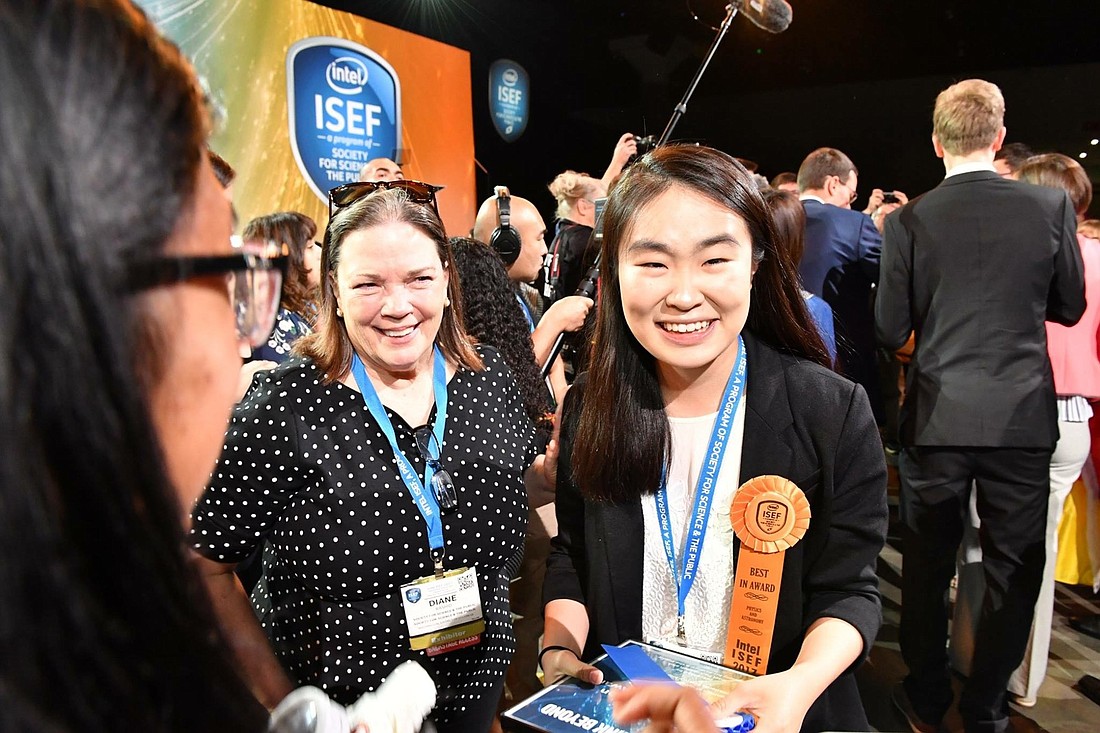- December 13, 2025
-
-
Loading

Loading

From a young age, 18-year-old Windermere resident Amber Yang knew two things: She loved science and space, and she wanted to compete in Intel’s International Science and Engineering Fair one day.
The week of May 14, she accomplished her goal — and then some. She was a top-three finalist, winning the Intel Foundation Young Scientist Award of $50,000.
And she had some tough competition. The Intel ISEF event — often called “the Super Bowl of science fairs” — was held this year in Los Angeles. It is only open to competitors who have won first place at a regional or state science fair. This year’s gathering showcased about 1,800 competitors from more than 80 countries, competing in 22 scientific categories.
The recent Trinity Preparatory School graduate only started competing in science fairs last year but has been working on her Intel ISEF project for about three years now. Titled “Multi-Orbit Space Debris Cloud Tracking Using Iterative Closest Points Registration with Machine Learning,” her project involves what she refers to as “space junk.”
“I created a computer system based off of machine learning and artificial intelligence, capable of tracking and predicting future locations of space junk,” Yang said. “(Space junk is) basically any type of defunct satellites or broken parts of spacecraft floating around, and there’s so much floating around in space now that it poses dangers to the International Space Station, operating satellites and even astronauts who are up there in space.”
“It’s competing with some of the brightest minds in the world, and I was speechless.”— Amber Yang
The current method of tracking space debris, Yang said, relies on a mathematical and static model, which has to be constantly and manually adjusted whenever the space debris orbit changes. The problem is the debris’ orbit changes all the time because of factors such as solar gravity, wind or radiation.
“All these things can cause the orbit to change unpredictably, and that becomes very cumbersome over time to adjust this model,” Yang said. “I wanted to think of a method that could learn for itself and how the orbits were changing.”
Her system uses artificial neural networks, which essentially operate the same way as the human brain. The network takes in data and learns and recognizes patterns — in this case, it learns how much the orbit changes over time and is able to update itself. The predictions are useful because they allow scientists to see where space debris is headed so they have time to move important spacecraft — such as the ISS — and satellites out of its way to avoid destruction.
“It takes its mistakes and learns and corrects its prediction,” she said. “I wanted to do something that could learn and constantly update and essentially be able to track the approaching debris.”
Yang began thinking about astrophysics in 2007, when China launched an anti-satellite missile test that destroyed one of its weather satellites. This was the largest recorded creation of space debris in history, with more than 2,000 pieces of trackable-size debris and up to 150,000 particles.
Because the United States was concerned about the welfare of its spacecraft and satellites. Yang became intrigued with the issue. She began her project a few years later by doing extensive research. She spent an entire summer and winter break poring over it, sometimes spending up to 14 hours per day working on it.
And this May, her hours of hard work officially paid off. She will be putting the prize money she earned toward her tuition at Stanford University this fall, where she wants to major in physics with a concentration in astrophysics. Eventually, she might pursue a doctoral degree in physics.
“I completely did not expect this; it’s been an insane ride,” she said of the Intel ISEF competition. “It’s competing with some of the brightest minds in the world, and I was speechless. It seemed like the perfect end to my science-fair career, definitely a great affirmation for me that all of the work I put in actually mattered, that people cared about it and a lot of scientists in the field thought it was a great research topic.”
Going forward, she will continue her passion for astrophysics and is currently thinking of better ways to package her creation so she can patent it or license it out to other companies for public use.
“Astrophysics is an amazing field, because it’s concerned with how the universe formed in the first place,” she said. “I really feel like these fields (physics, astrophysics) caught my attention because I can give back to humanity and help solve questions that are unanswered.”
Contact Danielle Hendrix at [email protected].